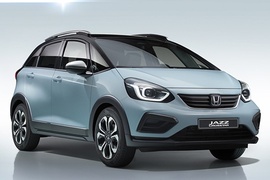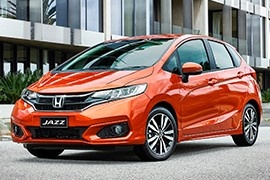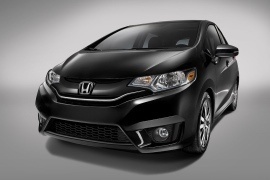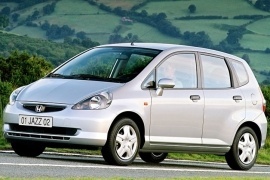
HONDA Jazz / Fit
Generations Timeline, Specs and Pictures

Honda still insists on trying to conquer the small-segment with a small MPV while everyone else builds hatchbacks.
So, they introduced the new Jazz/Fit. A small MPV that has been on the market since 2000 and it is now on its fourth generation. The previous generations were available only as city-vehicles.
This time, the Jazz also comes with a cross-over variant, called Jazz Crosstar, which features some plastic overfenders and SUV-inspired details, although underneath it is still a Jazz. But just remember that the crossover Honda HR-V also used the Jazz/Fit platform.
If the previous generation had a hybrid version, the 2020 Jazz has only hybrid units under the hood. An 98 hp gasoline engine is helped by an electric motor and the total output goes to 109 hp. Honda didn’t specify any performance data, but we will update the info on the way.
Inside, the MPV shape helps in getting a big interior room. The Magic Seats system for the rear seats was maintained. Also, the foldable rear seatback is still available. This means that the gas tank is still under the driver seat, leading to a higher driving position. The dashboard is in the Internet and connectivity age, with a big TFT as an instrument panel and a 9” touch-screen for the infotainment unit. The 2020 Jazz has Android Auto and Apple CarPlay.

Honda refreshed the second generation of the Jazz for the European market and upgraded both the exterior and the car’s drivetrain.
Stepping into the Euro 6 emission standard was a struggle for most carmakers, but Honda was ready and prepared the 1.5-liter engine since its early development stages. Also, it was among the first carmakers to introduce automated braking and the lane-keep-assist systems. But the Japanese carmaker didn’t just add the Euro6 mandatory features to the car and call it a day. It brought other improvements as well.
On the outside, the front side of the Jazz sported the new “Solid wing face” design resembling the signature front fascia from the CR-V, HR-V, and the Civic. On the sides, the sculptured door panels enhanced the car’s look, making it more dynamic. The bumper sported a pair of horizontal cuts on the lower side instead of the previously used vertical ones in the back.
The carmaker kept the interior from the non-facelifted version but added the cruise-control/speed limiter as a standard feature for the entire range. A new sport trim package was added to the options list, offered as an option for the base engine version and standard for the 1.5-liter model.
Under the hood, the most significant change was for the engine range, where Honda added the 130 hp unit carried over from the HR-V. It paired it with either a six-speed manual or a CVT. The same transmission options were available for the 1.3-liter base engine, while the 1.5-liter turbo-diesel received only a six-speed manual.

The Japanese car manufacturer tried to sell a little MPV into the small vehicle segment and, despite all the odds, it did.
And it was successful not only in Europe. The third generation of the Jazz/Fit was proof.
Even if some people are considering the Jazz as a hatch-back, it is more of a minivan in the sub-compact segment. There were more car manufacturers that tried the recipe in Europe and didn’t have any luck. But the little Jazz did.
For the third generation, introduced on the Japanese market in 2013 and a year later was launched at the 2014 North American International Auto Show as a 2015 model. The design was around the spaceframe used for the unibody construction. Since it used high-strength stell-alloys, it allowed the manufacturer to built the car even smaller than before, despite the “expand the car” trend of the market. The new headlights were in the same theme design with the Civic and the HR-V model. The ascending sideline was ended into connection with the rear, high-mounted taillights.
Inside, the cabin was very spacious for its class. The flat platform with torsion beam suspension on the rear allowed a special multi-configuration interior system that allowed the rear seats to be either folded or raised.
Under the hood, there were more engine options available, depending on the market. The base unit was a 1.3-liter, while the top-spec was a hybrid version equipped with a 1.5-liter Atkinson engine plus an electric motor.

The second generation of the small-sized MPV Honda Jazz was introduced in 2007 at the Tokyo Motor Show.
It was slightly bigger than its predecessor.
Even though the small-class MPV market was not big, the Japanese car-maker Honda decided to launch such a car in 2001. It looked like an evolution from the Japanese kei-cars. But it was more than that. It started a trend that no other car-maker was able to follow.
The egg-shaped Jazz featured a sloped front hood, which was continued by the raked windshield like they were drawn with one single line. The car’s designer, Daisuke Sawai, said that it draw it like that so there was no confusion. The arched roofline and the abrupt rear end was inspired by the bigger sibling, the Odyssey.
Inside, the car was very big for its size. The wide and tall windshield made the passengers feel like they were on open air. The dashboard was installed lower than on other cars and, on the passenger side, there were two storage compartments. The high seating position made possible a bigger leg-room for the rear passengers. One of the key features of the Jazz was the Magic-seats system, which allowed the rear seats to be folded or raised, creating a tall transport area, such as a plant.
For the engine compartment, Honda installed two gasoline engines for most of the market, and a third for specific ones. The platform was based on struts suspension for the front and trailing arms for the rear. The same platform was used for the Honda HR-V cross-over vehicle.

Honda tried to offer a bigger car in the small class segment, but the carmaker didn’t mean extended, but roomier, and that was the Fit/Jazz.
In 2001, Honda took ideas from the Japanese kei-cars and introduced them to the rest of the world with this little MPV. It was a mix between a small-sized hatchback and a compact-segment MPV. It used a new platform, which was later on used for the Honda City as well.
The egg-shaped minivan featured a raked front end with a short hood and a taller windscreen covering half of the car’s front area. A new bumper was fitted, with a touch of aerodynamic engineering on its sides. The tear-shaped headlights with clear lenses made it look like a bug, not a cockroach. On the sides, a slightly ascending beltline left room for big side windows and a short kick above the rear axle to form the D-pillar. In the rear, Honda installed new taillights with clear glass on their upper side for the reversing light instead of the previously used ones with a clear center section.
The interior was spacious for a car of its size. It provided room for five adults, but with not so ample hip space for the three rear passengers. One of the car’s best features was the seating versatility, with the “magic seats” feature that allowed the rear seats to be lifted or folded for extra loading storage. Unlike the non-facelifted version, it featured buttons on the steering wheel and a new, digital climate control unit.
Under the hood, the Fit/Jazz featured the same gasoline engine choice but upgraded to Euro4 pollution norms for the European continent. A CVT was available as an extra option for the 1.4-liter mill.

Honda introduced the Fit/Jazz on the market in 2001 as an alternative for the small-segment MPVs and sold it under Fit in Japan, China, and in the U.S. and as Jazz everywhere else.
With an increased need for small vehicles that could carry more than a regular small-segment hatchback, Honda thought it might have the answer and offered the Fit/Jazz starting with 2001. Previously, the Japanese carmaker had a few tryouts to build small-segment minivans, and some of them worked well.
This time, Honda designers made the car looks like a bullet or at least half of it. Its narrow, sloped front area looked like the entire car evolved from the front bumper’s base. The triangular headlights followed the car’s shape. On its sides, between the A-pillars and the door-frame, the carmaker installed a small window. Thanks to a slightly ascending beltline, the Fit/Jazz didn’t look that dull. An additional glass-area found its place between the rear doors and the D-pillars. From behind, the Fit/Jazz shown a set of triangular(ish) taillights that flanked the deep tailgate.
Inside, it was surprisingly spacious and offered enough room for five adults. Though, the carmaker installed only two headrests for the rear seats. The Fit/Jazz made room for up to 1323 liters (46.72 cu-ft) by folding down the rear bench.
Under the hood, Honda installed only two engine choices of 1.2-liter and 1.4-liter, which didn’t offer too much power, but provided an excellent fuel-efficiency.























































